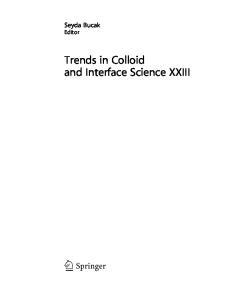Trends in Colloid and Interface Science IV
- PDF / 374,830 Bytes
- 5 Pages / 591 x 760 pts Page_size
- 61 Downloads / 332 Views
Progr Colloid Polym $ci 81:184-188 (1990)
Molercular dynamics simulations of colloids: Supercooled Yukawa systems N. Pistoor 1) and K. Kremer 2) 1) Institut fiir Physik, Johannes-Gutenberg-Universit/it, Mainz, FRG 2) Institut fiir Festk6rperforschung, Forschungszentrum Jiilich, Jtilich, FRG Abstract: We performed molecular dynamics simulations on one and two component Yukawa systems. Cooling the system down and inspecting pair distribution functions (pdt) and bond correlation functions (bcf) we found the one component system to crystallize into a bcc-like lattice rather than an fcc lattice which is the stable phase of the simulated system at low temperatures. Upon cooling the two component system freezes into a glassy state without exhibiting crystalline structure in pdf or bcf. We define particle excess functions which show that spacial fluctuations in the number density of particles of the different components decay quite slowly. Therefore we believe that a well defined state of the two component system can only be reached in simulations long enough to allow those fluctuations to decay. Key words: _Molecular d_ynamics;Y_ukawa potential; pair d_istribution function; bond _correlation function
The simulation
The model The effective interaction between two charged macroions in a dilute aqueous solution can be well described by a Yukawa-Potential [1]
U(r) = u 0 a e x p ( - 2r/a)
(1)
We performed molecular dynamics (MD) simulations for two different systems with parameters as displayed in Tab. 1 by integrating the equations of motion of the macroions
r
where a = n -1/3 is a typical interparticle distance and n = N / V is the particle number density. The prefactor U0 is proportional to the effective charges of the interacting particles. The energy scale is set by Ua = ( U ( a ) ) = ( U 0 ) e x p ( - 2 ) where the average is performed over all pairs of particles in the system. The state of a one component system (i.e. all particles carry the same effective charge) can be specified by two dimensionless parameters, the screening parameter 2 and the dimensionless temperature k T/Ua. The phase diagram (Fig. 1) which is known from previous simulations [2, 4] as well as from light scattering experiments on latex spheres [5] shows three different phases: fluid, bcc crystal and fcc crystal. In a two component system one expects suppression of crystallization in favour of a frozen but disordered ("glassy") state.
m--~-=
E ~rii,i
v(F,',- *jl)- r
c~t + Wi
(2)
for N particles in a cubic box of Volume V = N a 3 with periodic boundary conditions. The temperature was controlled by weakly coupling the particles to a heat bath by means of some friction constant F and a stochastic force W~ [6]. A typical timescale of the problem is given by the Einstein frequency • which is derived from a harmonic approximation to the mean effective potential Ueff(r) = n S g(r') U(] r - r' I)dr' .
(3)
By performing a Taylor expansion around r = 0 which gives
185
Pistoor and Kremer, Molecular dynamics simulations of colloids: Supercoole
Data Loading...











